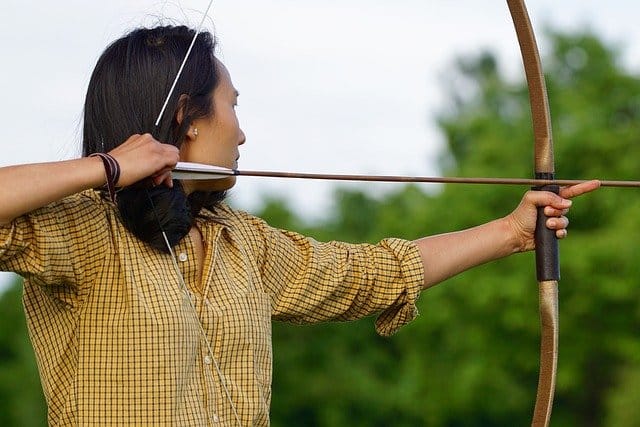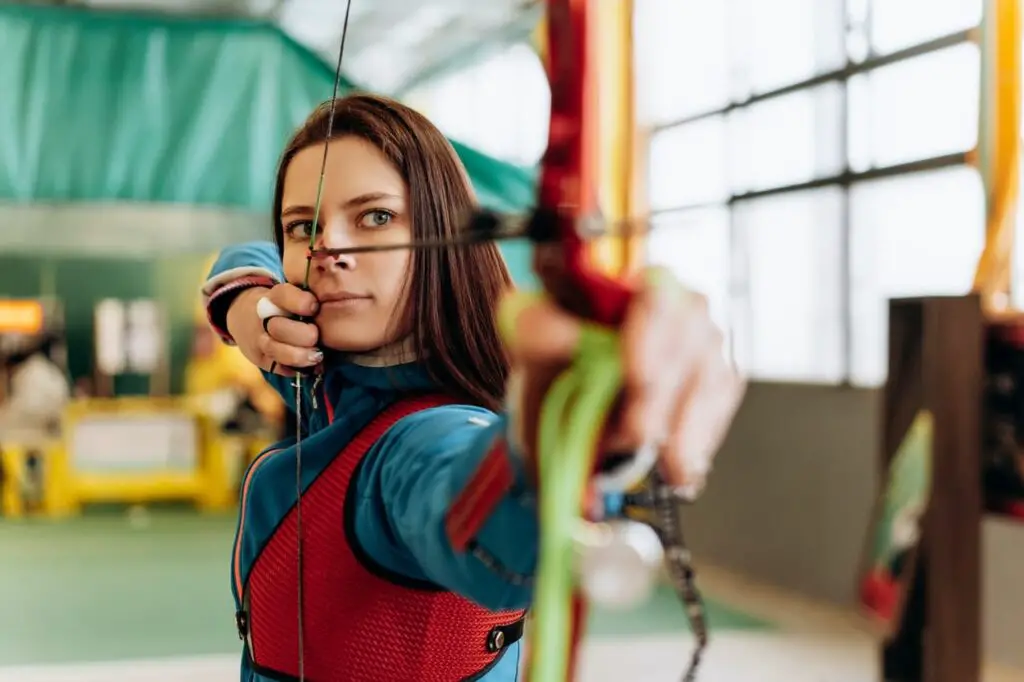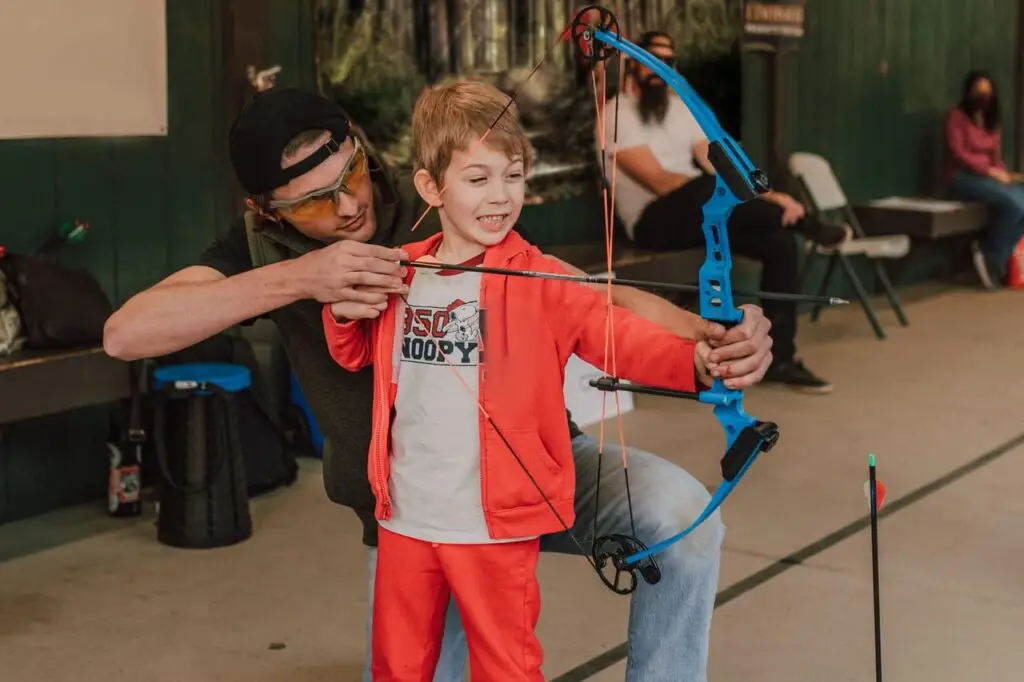Archery is becoming an increasingly popular sport, both in the sense of hunting and target shooting. When you participate in any sport, there is always a risk that you will injure yourself. Archery is not immune to causing injury to its participants.
Back pain from participating in archery is common, but as with any sport, pain should not be ignored. It is important to know the difference between muscle fatigue and muscle injury.
In this article, you will learn how archery can be the cause of back pain and what you can do to prevent the pain from occurring.

How Does Archery Cause Back Pain?
There are a couple of different ways archery can cause back pain, and you must know the root cause. If you do not take time to understand the cause, you could face more significant injury.
Common Muscle Fatigue
When using a bow and arrow, you will feel tightness or tension in your shoulder blades and upper back. This is because you are using muscles that are not typically used in day-to-day activities. When gauging the pain you feel, it should not be debilitating. This means it should not interfere with your day-to-day activities.
Injured Muscles
Pain during archery can also be a direct result of injury. If you have injured the muscles in your back, you may notice the pain worsening with certain activities. The pain will also likely make it difficult for you to participate in your daily activities.
Is Archery Good for the Back?
When practiced correctly archery offers several benefits for the back and overall posture. Drawing a bow engages key back muscles, promotes better posture, and strengthens the core.
However, it’s essential to use proper technique and be mindful of potential strains. Let’s delve deeper into the advantages and precautions of archery for back health.
Here’s why archery can be beneficial for your back and overall posture when practiced correctly:
- Strengthens Back Muscles: Drawing a bow requires the use of several muscles in the back, including the latissimus dorsi, rhomboids, and trapezius. Regular practice can help strengthen these muscles.
- Improves Posture: Proper archery form requires a straight and aligned posture. Over time, this can help improve your general posture even when you’re not shooting.
- Engages Core Muscles: Archery also engages the core muscles, which are essential for back health. A strong core can help prevent back pain and injuries.
- Enhances Coordination and Balance: Archery requires a lot of balance to maintain the proper stance and to aim accurately. This balance involves both the back and core muscles.
- Mental Benefits: Archery is not just a physical activity; it’s also a mental one. Concentrating on your target and tuning out distractions can be meditative and stress-relieving, which can indirectly benefit back health by reducing tension.
However, it’s essential to note a few things:
- Proper Technique is Crucial: Just like any sport or physical activity, using the wrong technique can lead to injuries. It’s essential to learn the correct form and posture from a qualified instructor.
- Potential for Strain: If you’re using a bow with a draw weight that’s too heavy for you, or if you practice for extended periods without adequate breaks, you could strain your back muscles.
- Existing Back Problems: If you already have back issues, it’s essential to consult with a healthcare professional before taking up archery.
Treatment For the Pain
If you find yourself experiencing pain during or after archery, you need to keep a close eye on it. While the pain may stem from muscle use, it could also indicate an injury that needs to be treated carefully. You may not want to rush to the doctor right away, but there are some things you should do to prevent further injury.
Rest the muscles. When you begin to experience muscle fatigue or pain, you must give your muscles a break. This does not mean that you become motionless, but it does mean that you provide the muscles with a much-needed break.
Many people will try to work through the pain, thinking it will help. This is partially true. If your muscles are just fatigued, it may be beneficial to continue with movement unless it becomes painful. However, if you continue to use injured muscles, you could potentially cause an injury that is much more difficult to heal.
Take anti-inflammatory medication. Sometimes you may be able to find relief from the pain with anti-inflammatories. While this is traditionally a go-to for many, it may or may not work to relieve the pain in your muscles. (Source: Apptiv)
Apply ice or heat. One of the most comforting things you can do to help relieve muscle pain is to apply heat, ice, or a combination of the two. It is important that you not leave the affected muscles for a prolonged period, as it could cause more pain or unintended injury.
Stretch. If you are experiencing muscle pain related to fatigue or overuse, it would be wise to engage in simple stretching activities. The act of slow and gentle stretching will help ensure the muscle continues to move. If you hold the muscles stationary for a prolonged time, they will tighten, increasing the pain. (Source: Web MD)
See a physician. If you have spent time attempting to treat the muscle pain or injury at home and do not notice relief, it would be wise to seek the advice of a physician or physical therapist. You must take this step if necessary to help ensure that further injury does not occur. (Source: Health Grades)
When visiting the physician, you must be able to describe where the pain is coming from clearly. This will help guide the physician when they create a treatment plan.
Form is Important to Prevent Back Pain
When you are taking part in archery, you must maintain the proper form during shooting. If you do not maintain proper form, you will inevitably suffer from injuries after participating in the sport.
Read if archery can cause muscle imbalance.
Archery Form
The form you take when participating in archery will depend on the situation you are in. If you are shooting a target for sport, you will have ample time to prepare your stance. However, if you are in a tree or hunkered down in the woods, you will not have a lot of time to focus on the form. The proper form has key components that can be used no matter the situation.
Stand straight and tall. The act of standing straight and tall helps to ensure the proper muscles will be engaged when you pull back the bow. It is important to note that standing straight and tall does not mean stiff. It would be best if you had some degree of relaxation, or you will begin to use muscles other than your back and shoulders to pull the bow.
Foot position. Keeping your feet shoulder-width apart when preparing to pull the bow will help your body to remain fully balanced as you are shooting. When standing with your feet shoulder-width apart, it is important that you evenly balance your weight on your feet. Make sure your head is in line with your spine, and your feet are solidly on the ground.
Keep your head steady. Make sure you are not leaning forward or backward when you are pulling the bow back. The easiest way to achieve this is by keeping your head steady during the pull.
There are many other factors to consider when working on your form when it comes to archery. The most important thing to remember is that you do not want your body to be tense. Extra tension will invite injury to occur.
Read about: Does archery require a lot of strength?
Final Thoughts
Archery is a hobby that many different people around the world enjoy. While it may not seem like a physically demanding sport, it is a sport that can cause muscle injury quite easily. Some back pain is common with muscle use, but excessive back pain is a warning that something may be off with your form or technique.


